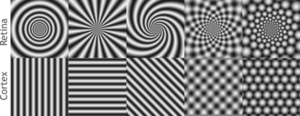Phosphene
A phosphene can be defined as the perception of light with no light actually being present. This entoptic (within-eye) phenomenon can include the perception of colors, flashes of light, and dots of light and dark that are not physically present. These can be seen in an entirely sober state and are colloquially referred to as "seeing stars".[1][2] The word phosphene is derived from the Greek phos for light, and phainein meaning to show; this roughly translates to "a presentation or manifestation of light(s)."[3]
Phosphenes occur naturally and can be induced any time there is a stimulation of the cone cells at the back of the retina in the absence of external visual input. Such natural mechanical or metabolic reactions capable of producing phosphenes include, but are not limited to: sneezing, crying, laughing, squinting, low blood pressure, oxygen deprivation, traumatic brain injury, or any other underlying mechanism that mimetically stimulates proper photoreceptor transduction to the visual cortices while immediate visual stimuli are temporarily excluded. Although this is not a strict requirement to produce them, phosphenes become much more prominent in dark or very low light conditions.[citation needed]
The most common (and easiest) way to induce phosphenes within the human perceptual field is mechanical; for example, using one's fingers to apply a light pressure on the back of the eyelids, with the eyes fully closed, will consistently produce phosphenes without fail. The prominence of perceived phosphene production appears to be directly correlated to the amount of pressure placed upon the eyes in this state. This physical method of phosphene induction is historically well documented and has been noted since as early as the Greco-roman period.[citation needed]
Other mechanisms known to create phosphenes within the human body include the use of direct electrical brain stimulation, transcranial magnetic stimulation, certain underlying neurological disorders, or ingestion of hallucinogenic substances.[citation needed]
History
The first serious inquiries into understanding the science behind phosphene production began in 1819 by Czech physiologist Johannes Purkinje, for which Purkinje images, Purkinje Trees, Purkinje's blue arc, and the Purkinje fibers of the heart are named. Further research began in the mid-1800's, with the work of Moreau and de Boismont; however, it was not until 1926 when the work of Henrich Kluver was able to attribute and link certain hallucinogenic drug intoxications to phosphene and form constant style hallucinations. Continuing research by Otfrid Foerster, and later Max Knoll, began to elucidate the electrical mechanisms underlying the neural production of phosphene forms, illuminating new avenues for possible research into phosphenes.[citation needed]
Form variety and underlying neurological understanding
Phosphenes can be perceived in a variety of forms, depending on both a combination of retinal photoreceptor coordinate array and layout of cortical neurons within the primary visual cortex (V1).[citation needed]
Retinal phosphenes are extant as a mathematical projection of the retina's cylindrical shape upon the neurological processing centers of the visual cortex, and thus often produce the tunnel-like properties or kaleidoscopic manifestations of phosphene organization; while relative cortical layouts produce the wave-like flickering and pulsing within the contrasting, delineated levels of flashing luminosity.[citation needed]
See also
- Psychonautics
- Sensory deprivation
- Internal hallucinations
- Prisoner's cinema
- Visual snow
- Form constants
References
This article does not cite enough references. You can help by adding some. |

